
biology laboratory manual
Discover essential experiments, procedures, and techniques in our comprehensive Biology Lab Manual. Perfect for students and educators to master biology concepts.
Welcome to the Biology Laboratory Manual, designed to enhance your understanding of biological concepts through hands-on experiments and critical thinking. This manual provides a comprehensive guide for introductory biology courses, blending theoretical knowledge with practical lab experiences. It includes essential techniques, safety protocols, and inquiry-based activities to foster a deeper appreciation of scientific methods and biological principles. Each section is structured to promote active learning, making it an indispensable resource for biology students.
1.1 Purpose of the Biology Laboratory Manual
The purpose of the Biology Laboratory Manual is to provide students with hands-on experiences that enhance their understanding of biological concepts. It encourages critical thinking, scientific inquiry, and the application of experimental design. Designed for introductory biology courses, the manual offers a blend of foundational principles and practical laboratory techniques. It includes experiments that are safe, easy to perform, and suitable for large classes. The manual aims to foster a deeper appreciation of scientific methods and biological processes, making it an essential resource for students to explore concepts like cellular biology, molecular techniques, and ecological studies in a structured and engaging manner.
1.2 Structure and Organization of the Manual
The Biology Laboratory Manual is organized into clear, logical sections to facilitate easy navigation and learning. It begins with an introduction, followed by essential laboratory skills and techniques, and progresses through cellular biology, molecular techniques, dissection, ecology, and experimental design. Each section is divided into subheadings that focus on specific topics, ensuring a coherent flow of information. The manual includes detailed descriptions of experiments, safety protocols, and resources for further learning. This structured approach allows students to build skills progressively, reinforcing concepts and preparing them for advanced studies. The organization ensures that each chapter and subheading is self-contained, making it easy to reference and review specific topics as needed.
1.3 Safety Protocols and Laboratory Etiquette
Safety is a top priority in the biology laboratory. Students must adhere to strict protocols, including wearing personal protective equipment (PPE) like gloves and goggles. Proper handling of equipment, chemicals, and biological specimens is essential to prevent accidents. Clear procedures for waste disposal, especially biohazardous materials, are outlined to ensure environmental and personal safety. Emergency procedures, such as fire evacuation plans and first aid, are emphasized. Laboratory etiquette includes maintaining a clean workspace, respecting shared equipment, and following instructor instructions. These guidelines ensure a safe and efficient learning environment, allowing students to focus on their experiments without unnecessary risks.
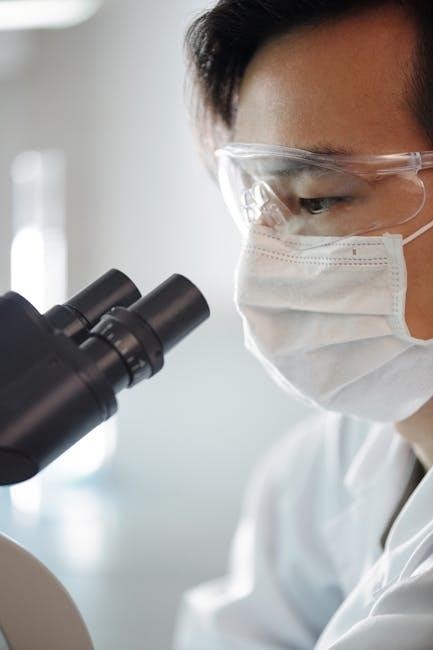
Essential Laboratory Skills and Techniques
Mastering measurement, microscopy, and solution preparation is crucial for effective experimentation. These foundational skills enhance accuracy, observation, and analysis in biological studies.
2.1 Measurement and Calibration of Laboratory Equipment
Accurate measurement and calibration of laboratory equipment are essential for reliable experimental results. This section covers techniques for using microscopes, balances, and other tools, ensuring precision in biological studies. Proper calibration prevents errors, while regular maintenance prolongs equipment lifespan. Understanding measurement units and conversions is critical for data consistency. By mastering these skills, students can confidently conduct experiments, analyze data, and draw valid conclusions. This foundational knowledge is vital for all laboratory work, enabling precise and reproducible results in biology experiments.
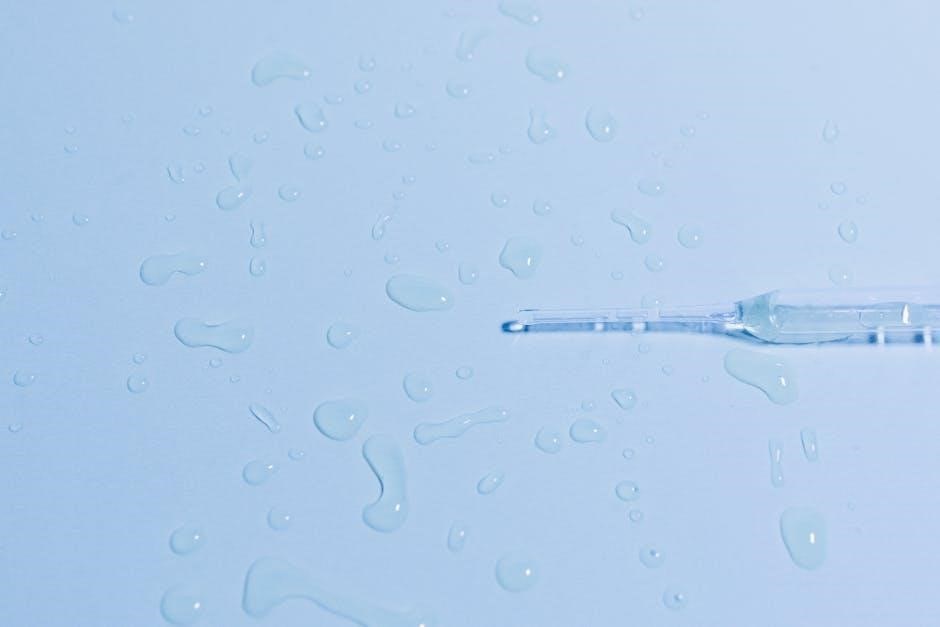
2.2 Microscopy: Proper Use and Maintenance
Mastering microscopy is fundamental for observing biological specimens. Start by familiarizing yourself with microscope parts, including objective lenses, eyepieces, and the stage. Always handle lenses with tissue to avoid smudging. To focus, begin with low magnification, then switch to higher power. Clean lenses with lens paper to maintain clarity. Properly prepare slides by placing specimens centrally and securing them with coverslips. Adjust lighting by lowering the condenser and increasing light intensity for optimal visibility. After use, clean and store the microscope in a dry, secure location. Regular maintenance ensures longevity and precision in observations.
2.3 Preparation of Solutions and Reagents
Preparing solutions and reagents accurately is crucial for reliable experimental results. Start by calculating concentrations using molarity formulas (M = moles/solvent liters). Use distilled or deionized water to prevent impurities. For dilutions, transfer the stock solution to a volumetric flask and dilute to the marked level. Sterilization methods, like autoclaving or filtration, ensure microbial control. Label solutions with their name, concentration, and date. Store reagents in appropriate containers, following safety guidelines for hazardous materials. Always refer to standard protocols to maintain consistency and avoid contamination. Proper preparation ensures precise and reproducible outcomes in biological experiments.
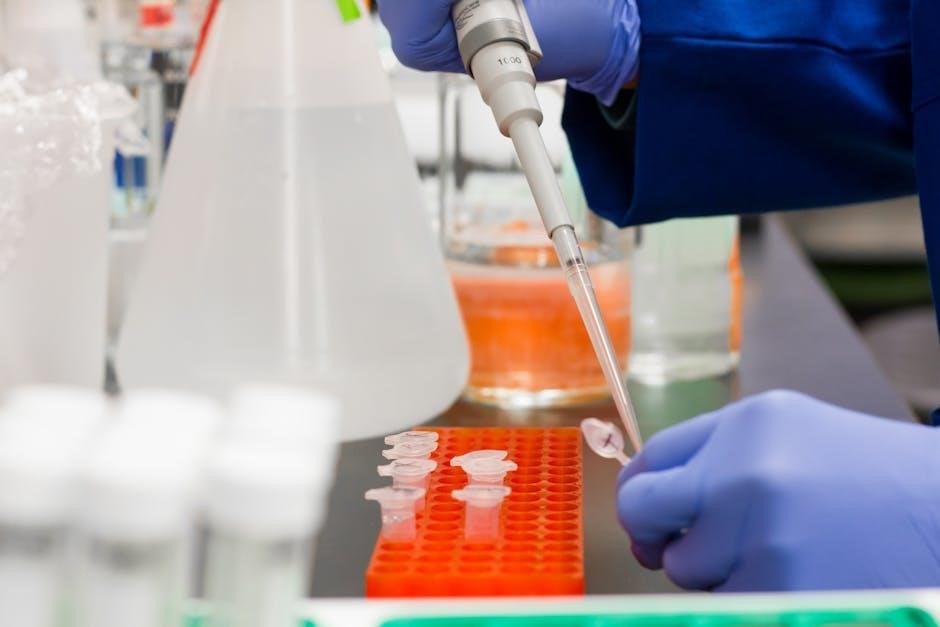
Cellular Biology Experiments
This section explores fundamental cellular processes through hands-on experiments. Students investigate cell structure, membrane transport mechanisms, and cellular division. Practical activities enhance understanding of cellular function and dynamics.
3.1 Observing Cell Structure with a Light Microscope
This experiment introduces students to the proper use of a light microscope to observe cellular structures. By preparing temporary wet mounts of plant and animal cells, students learn to identify key features such as the cell wall, nucleus, and cytoplasm. The activity emphasizes the importance of focusing techniques, magnification, and staining methods to enhance visibility. Students also practice drawing and labeling observed structures, fostering accurate scientific documentation. This hands-on exercise bridges theoretical knowledge with practical observation, helping students understand the morphology and organization of cells in a biological context.
- Preparation of temporary wet mounts.
- Use of stained samples for clearer observation.
- Recording detailed drawings of cellular structures.
3.2 Cell Transport: Osmosis and Diffusion
This section explores the fundamental processes of osmosis and diffusion, essential for cellular survival. Students investigate how substances move across cell membranes, with diffusion involving the passive movement of particles from high to low concentration, while osmosis focuses on water movement through semipermeable membranes. Experiments include observing osmosis in plant cells and using dialysis tubing to simulate membrane transport. These activities demonstrate the role of concentration gradients and membrane selectivity in regulating cellular environments.
- Understanding concentration gradients.
- Distinguishing between osmosis and diffusion.
- Conducting experiments with semipermeable membranes.
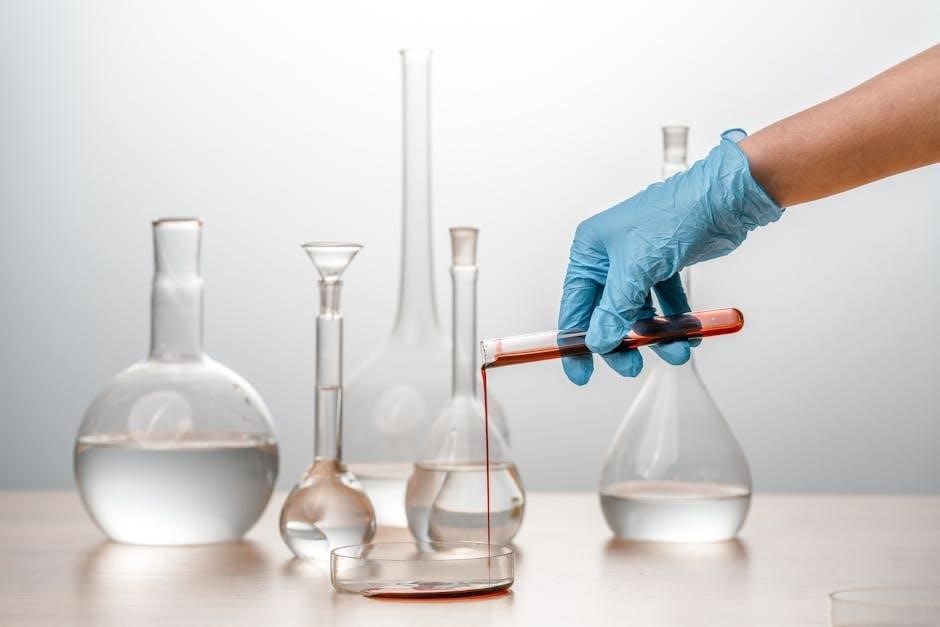
3.3 Mitosis and Meiosis: Stages and Observations
Mitosis involves stages like prophase, metaphase, anaphase, telophase, and cytokinesis, resulting in two identical diploid cells. Meiosis includes two divisions: meiosis I (prophase I, metaphase I, anaphase I, telophase I) and meiosis II (prophase II, metaphase II, anaphase II, telophase II), producing four haploid cells. Lab activities involve preparing and examining slides under microscopes to observe these stages. Key differences include homologous chromosome pairing in meiosis I and chromosome number reduction. These processes are crucial for understanding genetics and reproduction.
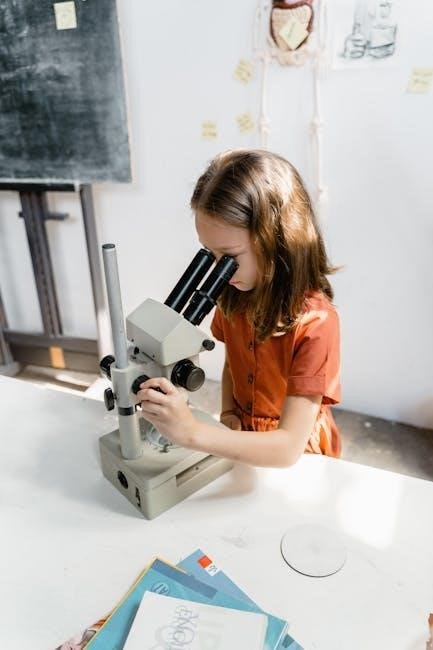
Molecular Biology Techniques
This section explores essential techniques in molecular biology, including DNA extraction, PCR, and gene amplification, providing foundational skills for genetic analysis and biotechnological applications.
4.1 DNA Extraction and Purification
DNA extraction and purification are fundamental techniques in molecular biology, enabling the isolation of high-quality DNA from various sources like blood, tissues, or plants. The process typically involves cell lysis using enzymes or detergents to release DNA, followed by separation from proteins and other contaminants using methods such as phenol-chloroform extraction or silica-based columns. Purification steps may include ethanol precipitation and washing to remove impurities. The quality and purity of the extracted DNA are crucial for downstream applications like PCR or sequencing. Techniques like spectrophotometry assess DNA concentration and purity, ensuring optimal results in genetic analysis and biotechnological applications.
4.2 Polymerase Chain Reaction (PCR): Basics and Applications
Polymerase Chain Reaction (PCR) is a widely used molecular biology technique to amplify specific DNA sequences rapidly. It involves repeated cycles of three main steps: denaturation (separating DNA strands), annealing (primers binding to target sequences), and extension (synthesizing new DNA strands). Essential components include primers, dNTPs, and thermostable DNA polymerase like Taq. PCR is highly sensitive and specific, enabling amplification from small DNA samples. Applications include forensic analysis, genetic testing, disease diagnosis, and cloning. Advances like real-time PCR allow quantification of DNA, while reverse transcription PCR (RT-PCR) amplifies RNA, aiding in studying gene expression and detecting pathogens, such as in COVID-19 testing.
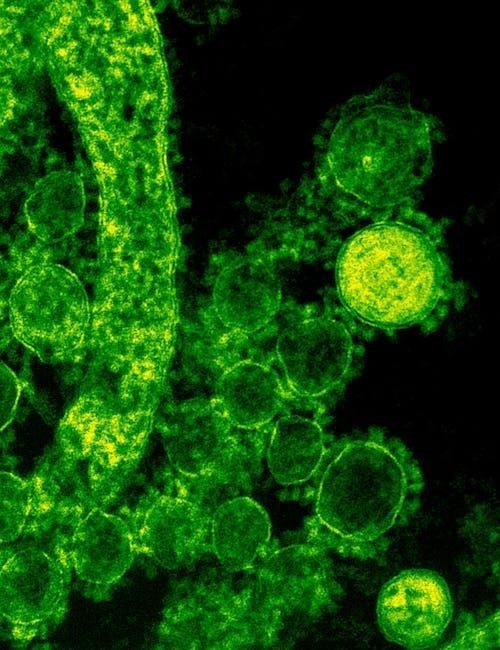
Dissection and Histology
Dissection involves detailed anatomical study of organisms, while histology focuses on tissue structure analysis. Both techniques enhance understanding of biological systems and their functional relationships.
5.1 Dissection of Model Organisms
Dissection of model organisms, such as frogs, worms, or fruit flies, provides hands-on experience to study anatomy and developmental biology. Students learn to identify organs and tissues, understanding their functions and interconnections. Proper techniques involve precise incisions, organ identification, and careful observation. Tools like scalpels, forceps, and magnifying glasses are essential. Safety protocols, including gloves and goggles, are emphasized. Dissection fosters analytical skills and enhances understanding of complex biological systems. It also encourages exploration of evolutionary similarities and differences among species, bridging theoretical knowledge with practical application.
5.2 Preparation and Staining of Tissue Sections
Preparation and staining of tissue sections are essential steps in histology, enabling detailed microscopic analysis. The process begins with tissue fixation to preserve structure, followed by dehydration, embedding in paraffin or resin, and sectioning into thin slices using a microtome. Staining, such as with hematoxylin and eosin (H&E), enhances tissue contrast. Specialized stains like Gram or PAS target specific structures. Proper technique ensures clear visualization of cell and tissue features, aiding in the study of normal and pathological conditions. This method is fundamental for understanding cellular organization and diagnosing diseases, making it a vital skill in biology and medical research.
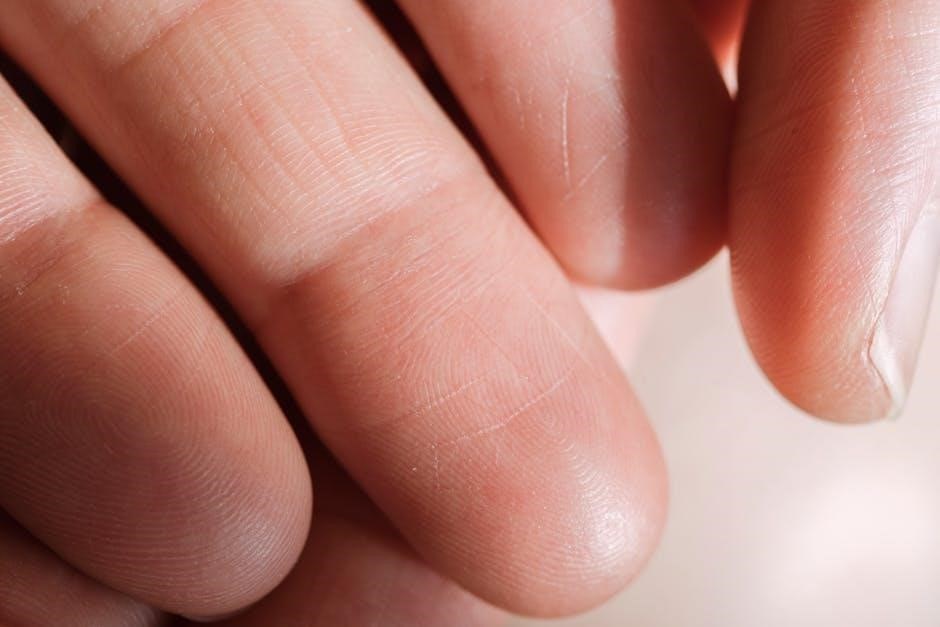
Ecology and Environmental Biology
Ecology and environmental biology explore interactions between organisms and their environment, focusing on ecosystems, biodiversity, and human impacts. Laboratory studies include field sampling, species identification, and environmental analysis techniques.
6.1 Field Studies and Ecological Sampling
Field studies and ecological sampling are essential for understanding natural ecosystems. Students learn to collect and analyze data on biodiversity, population dynamics, and environmental factors. Techniques include quadrat sampling, transect studies, and pitfall traps to measure species distribution and abundance. Proper use of tools like GPS and environmental sensors is emphasized.
Sampling methods are designed to minimize ecological impact while ensuring accurate data collection. Exercises focus on identifying sampling biases and improving precision. These skills are critical for conducting realistic ecological assessments and forming hypotheses about ecosystem functions and human influences on the environment.
6.2 Analyzing Local Ecosystems
Analyzing local ecosystems involves identifying and studying the interactions between biotic and abiotic components. Students learn to assess biodiversity, measure environmental factors like pH and temperature, and observe nutrient cycling. Techniques include soil analysis, water quality testing, and species identification using field guides.
Data collection focuses on understanding energy flow, food webs, and ecosystem health. Practical exercises emphasize identifying human impacts, such as pollution or habitat disruption. These analyses provide insights into ecological balance and conservation strategies, preparing students to address real-world environmental challenges effectively.
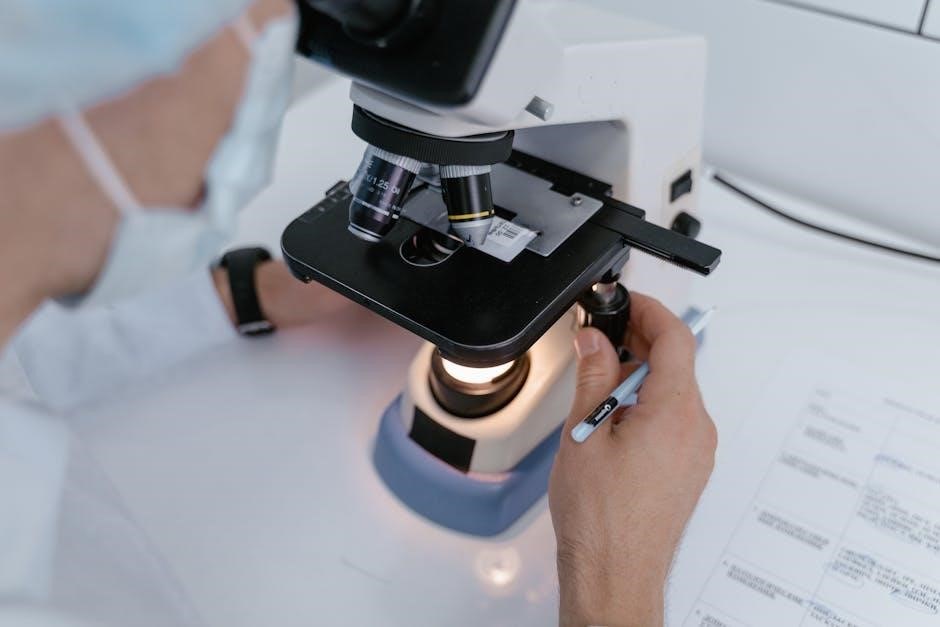
Scientific Method and Experimental Design
The scientific method is a systematic approach to explore biological questions, involving observation, hypothesis, prediction, experimentation, and conclusion. Experimental design ensures controlled, objective, and reproducible investigations.
7.1 Formulating a Hypothesis
Formulating a hypothesis is a critical step in the scientific method, involving the creation of an educated guess to explain observed phenomena. A hypothesis must be testable, specific, and falsifiable, providing a clear framework for experimentation. It is derived from careful observation, prior knowledge, and research. For example, if observing that plants grow faster in sunlight, a hypothesis might predict that light intensity directly affects growth rate. A well-crafted hypothesis guides experimental design, ensuring investigations are focused and objective. It is essential to state hypotheses concisely, using measurable terms to facilitate validation or refutation through data collection and analysis.
7.2 Designing and Conducting Experiments
Designing and conducting experiments is a systematic process that tests hypotheses and gathers data. A well-designed experiment identifies variables (independent, dependent, and controlled), ensuring clarity and focus. It establishes a clear objective, selects appropriate methods, and outlines procedures for data collection and analysis. Experiments should minimize bias and ensure reproducibility. When conducting experiments, adherence to protocols is crucial, along with precise measurements and detailed record-keeping. Researchers must also consider ethical and safety standards. After collecting data, results are reviewed to refine the experiment or draw conclusions. Proper documentation and transparency are essential for validating outcomes and enabling peer review.
7.3 Data Analysis and Interpretation
Data analysis involves organizing, evaluating, and interpreting experimental results to draw meaningful conclusions. It includes summarizing data using statistical methods, creating graphs, and identifying trends or patterns. Interpretation links findings to the hypothesis, determining whether results support or reject it. This step requires critical thinking to explain observed phenomena and address potential sources of error. Accurate documentation and transparency in methods are essential for credibility. Effective communication of results, often through reports or presentations, ensures findings are accessible and understandable. Data analysis and interpretation are critical for validating experimental design and informing future research directions in biological studies.
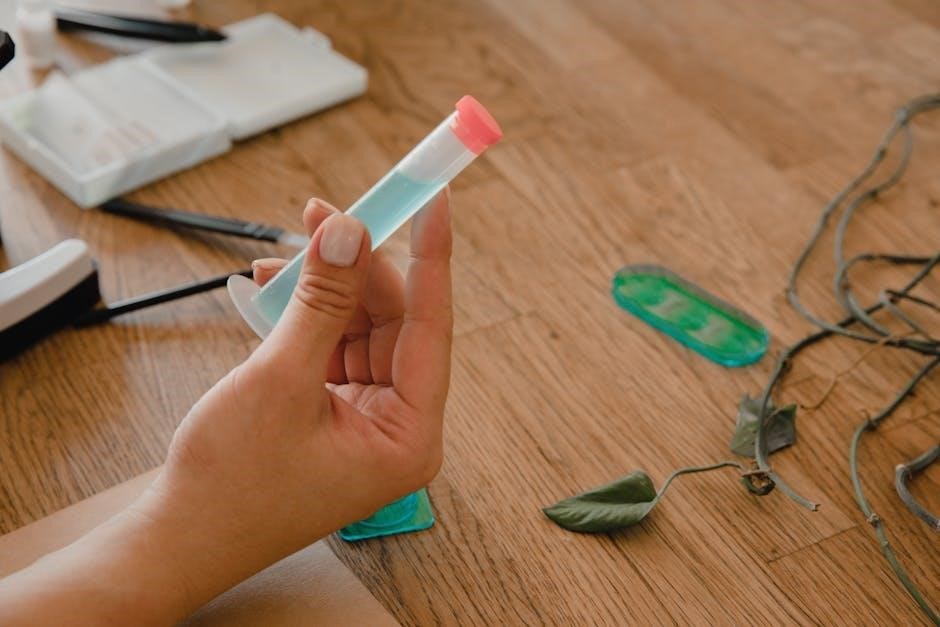
Resources and References
This section provides essential resources, including textbooks, online databases, and laboratory guides, to support students and researchers in their biology studies and experiments for both theoretical understanding and practical applications.
8.1 Recommended Laboratory Manuals and Guides
Several laboratory manuals are highly recommended for biology students, offering detailed protocols and experiments. Titles such as Biology Laboratory Manual by Jane B. Reece and Laboratory Manual for Biology by Susan J. Karcher provide comprehensive coverage of essential techniques. These guides include step-by-step instructions, safety precautions, and expected outcomes, ensuring a solid foundation for laboratory work. They also incorporate modern methods and ethical considerations, making them invaluable for both beginners and advanced learners. Supplementary online resources, such as video tutorials and interactive simulations, further enhance understanding and practical skills in a biology laboratory setting.
8.2 Online Tools for Biology Students
Online tools have become indispensable for biology students, offering interactive learning experiences and access to scientific resources. Websites like PhET Interactive Simulations provide virtual labs for exploring biological processes. Platforms such as NCBI and PubMed offer extensive databases for molecular biology and research articles. Tools like Khan Academy and Coursera provide structured courses and tutorials. Additionally, YouTube channels dedicated to biology, such as Crash Course Biology, deliver engaging video content. These resources enhance learning, promote understanding of complex concepts, and support experimental design and data interpretation, making them essential for biology students at all educational levels.